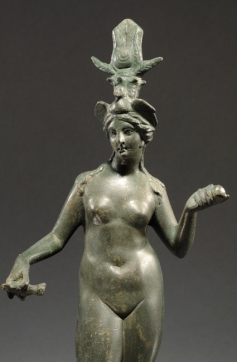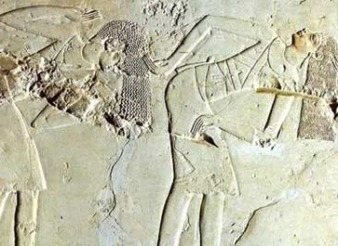Last time we saw that there is no evidence for temple prostitution in ancient Egypt. Yet we still find writers (usually well-meaning ones discussing sacred sexuality) who tell us that Isis spent ten years as a prostitute in Tyre, that She was beloved by prostitutes, and that Her temples were located near brothels and were reputed to be good places to meet prostitutes.
Where does all that come from?
Well, this is definitely one of those “consider the source” situations.
The bit about prostitution in Tyre is from Epiphanius, a 4th century CE Christian bishop writing against what he sees as heresies. He complains about the sister-brother marriage of Isis and Osiris then launches into the prostitution accusation. There’s no other evidence of this story circulating at the time. He may have made it up. He may have confused Isis with Astarte or even with Simon Magus’ muse Helena, who was a prostitute in Tyre (before being recognized as the Thought of God and the reincarnation of Helen of Troy and rescued by the magician; but that’s a whole other story).
The “tradition” connecting Isis with prostitutes and prostitution comes from a couple of sources; both worthy of clear-eyed consideration (see above). Cyril, Christian bishop of Alexandria in the 5th century CE wrote that “the Egyptians,” especially the women (!!!), when they were made initiates of the religion of Isis “are deemed worthy of honor—therefore of wantonness.” (On Adoration in Spirit and Truth, 9) But before him, a number of Roman poets and satirists made such claims in relation to devotion to Isis. Her temples were supposed to be great places to meet loose women. And then there was the famous Isiac scandal, told by the Jewish historian Josephus, in which a Roman matron was supposedly tricked into going to the Temple of Isis so that “Anubis” could sleep with her.
When you look more closely into these accusations and put them in context, you see that the poets complained not only of temples of Isis, but of anywhere in Rome where women either gathered (the temples of a wide variety of Goddesses as well as just about any public space, for instance) or went to protect their interests (such as courts of law). If women are allowed to run around loose, lewdness is sure to follow.
It’s pure misogyny, folks. (One of these poets, the appropriately named Juvenal, wrote a poem called Against Women, in case I have not already made myself sufficiently clear.)
Without seeing the irony, several of these poets would write about sexual immorality and the temples of Isis, then turn around and complain when their mistresses would abstain from sex for a period of ten days as part of their devotion to Isis. (This period of abstention was known as the Castimonium Isidis or “Chastity of Isis.” Surely it was intended as a purification prior to some important Isiac rite.)
In fact, we have far more evidence for morality and chastity among Roman Isiacs than we do for sexual promiscuity. I’m sure it happened. Humans. Sex. But it wasn’t part of the temple proceedings.
So now we know. But that was Rome, and rather late. What about Egypt?
We know there were exuberant religious celebrations that included drinking and dancing in Egypt. In the 5th century BCE, Herodotus notes a celebration for Bastet in which boats full of men and women traveled to Bubastis, laughing, singing, clapping, rattling (sistra?) and playing flutes, the women hurling ritual abuse at other women along the riverbank and some raising their skirts to expose themselves to the crowd. The historian notes that more wine was drunk during that festival than all the rest of the year. You know there was some drunken sex going on. Surely this was a festival meant to inspire fertility in the land and in the people. I’ll bet it did, too. Festivals of drunkenness were also celebrated for Hathor. And a recently discovered and translated papyrus, dating back 1900 years, appears to be a fictional story about a devotee of Mut who seduces someone into joining the sexy, drunken festivities for that Goddess.
I’m not aware of a festival of drunkenness for Isis. The emotionalism associated with Her cult is the sorrow of lamentation—and eventually the joy of reunion with the Beloved. But there is good reason to think of Isis and sex. After all, She is one of the Deities to Whom one prayed for children; and naturally, one must take physical-world action along with one’s prayers. Furthermore, the story of Isis and Osiris has at its heart a sexual coupling. The Goddess magically resurrects Her husband in order that They may make love one last time and so conceive Their child, Horus.
A very unusual 2002 find at Osiris’ temple at Abydos may provide some information. It appears to be a votive offering and shows a woman and man having intercourse. Unlike most Egyptian representations of sex, it is neither crude nor satirical. The man is particularly well endowed, and in contrast to most male-female depictions, the woman is shown larger than the man. Because of the fragmentary nature of the carving, we can’t be sure what sexual position is intended, but it may be that she is straddling him. If so, then perhaps this is because she is intended to be in the Isis (or Nuet) position of woman-on-top.
Best guess is that it was a votive offering to promote fertility, even though such offerings were usually in the form of a phallus or a “fertility figure” (such as one of the big-haired wasp-waisted “paddle” dolls). There was a separate shrine of Isis at Abydos, but archeologists studying the votive have suggested that there might have also been an Isis shrine in the Osiris temple itself and thus the sexual votive would be even more appropriate. Sex is crucial to Isis and Osiris as well as to the Egyptian dead. Sex is part of the magic of renewal and rebirth. It is the magic Isis works with Osiris. It is the magic the Goddess in Her many names works for the dead. (See my post on Isis as a sexy Goddess here.)
In the early days of my relationship with Isis, one of the things She asked of me was that my lovemaking be given in Her name. Now, it could be that the researchers’ guess is correct and that the votive was an offering made to ask for fertility. But perhaps this unusual and somehow poignant votive offering was an expression of the same sort of thing that Isis asked of me so long ago. Perhaps it is a reminder that lovemaking is sacred, that it is a vital part of Isis’ magic of renewal, and that we should honor it as She does.








